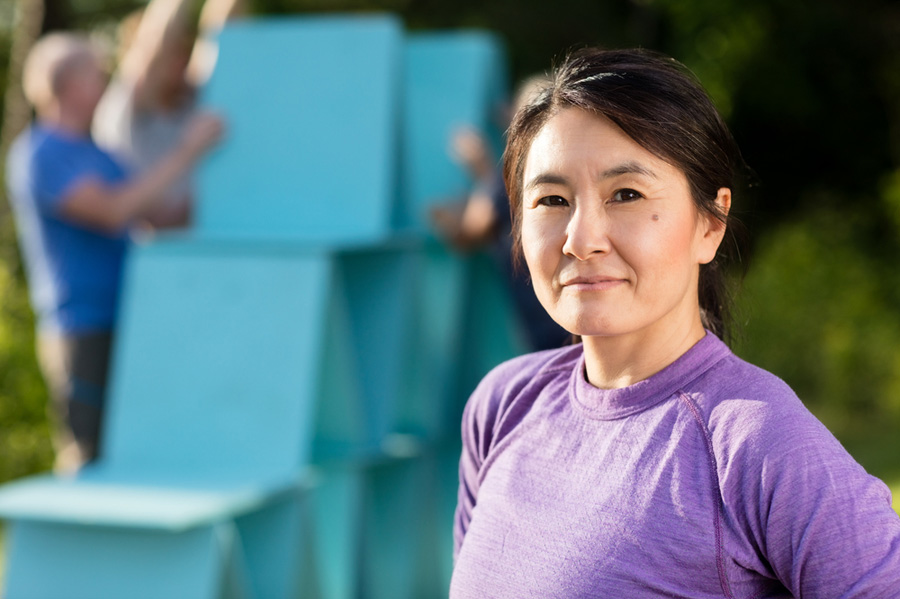Balance is so important–particularly as we age. We are concerned about balance because we are concerned about falling (and we should be). Falling is the number one cause of hip fracture. Nearly 20% of all hip fractures in the elderly will result in death within the first year, and 50% of people will never regain their prior level of function.
Poor balance and the fear of falling are the primary reasons for declining mobility and can ultimately affect how well you age. Lack of mobility leads to further decline including: worsening balance; worsening arthritis and pain; and negative effects on diabetes, heart disease, and osteoporosis. It generally leads to a declining quality of life. Mobility is an important element of life. The worse one’s balance becomes, the more difficult it is to be mobile.

Understanding Balance
Balance is primarily affected by five different body systems working in combination with each other:
- Muscle Strength and Boney Stability – In general, we have to have the strength and bone structure to actually hold ourselves upright. If we don’t have this, the other aspects of balance don’t mean much. Consider a baby or someone with paralysis. Without adequate strength or if you have a severe fracture, you are unable to balance.
- Somatosensory – This is the integration of the neurological system (including the brain and nerves throughout the body) with the musculoskeletal system. This includes all the touch and movement nerve receptors in the muscles, tendons, and joints. This also includes our ability to distinguish between hot and cold. One term you may be familiar with is proprioception. It’s a fancy word describing our brain’s ability to know where we are located in space. For example, if we close our eyes and lift our arms overhead, we know where our arms are located. A common problem affecting the somatosensory system is neuropathy. One very common form of neuropathy is from diabetes. Neuropathy is when the nerve cells (typically in the extremities like hands and feet) will die. This may be due to poor blood supply, trauma, infection, disease or even side effects from medication. The death of the nerve is the “neuropathy” which presents initially when a person may feel cramping, shooting or burning pain. Ultimately, it affects the one’s ability to feel sensations which causes numbness. Having numb feet makes it very difficult to balance!
- Eyesight – Humans are very eyesight dependent when it comes to balance. We rely heavily on our eyesight for mobility and to know where we are located in our environment. Have you ever tried closing your eyes when standing or been in a room that was so dark it was hard to tell which direction was up? Now imagine you have an eye condition such as glaucoma, cataracts or you wear bifocals. This affects your ability to see and your depth perception—ultimately, affecting your balance. Your eyesight is not just about the acuity at which you see, but is also important when you think of how you see. Gaze stabilization is how well you can stabilize a target in your field of vision. For example, can you stay focused on a moving object or can you move and keep the object in focus? Your eyes must be able to hold an object in focus or quickly move from one object to the next. Your eyesight is also interconnected with your vestibular system.
- Vestibular System – Our vestibular system is our inner ears. It provides us with information on head acceleration and gravity. It also works closely with our brains to process information on the head’s position in its environment. It helps us produce reflexes which affect our sense of equilibrium and our eyes’ ability to hold a gaze on a desired target. If you have ever experienced vertigo, then you understand how bad it feels when your vestibular system is malfunctioning. Like a child on the merry-go-round, this system may be fun to stimulate. The vestibular system is one of the more adaptable systems, and with practice, it can be improved.
- Central Nervous System – The brain is responsible for coordinating all of the information gathered by the body’s other systems. If the brain is damaged through trauma such as concussions, motor vehicle accidents, and war, then its ability to process information relating to balance could be affected. Another factor could be infections from virus, bacteria, fungal or a disease process such as Alzheimer’s or Parkinson’s disease. Strokes or aneurisms can also affect balance. If you have been affected by any of these, treatment should be sought from a qualified medical practitioner.
The key to helping you improve balance is to understand why your balance is worsening in the first place. Balance is affected by any one or a combination of the body systems listed above.
In my video, Prevent Falls, Improve Balance, and Age Well, I address the five body systems that are responsible for helping us maintain balance in more detail and what can we do to improve them.
Now that we understand some of the basic components to balance, it’s easy to understand why balance is so complicated, yet so important, and why it must be an area of focus. To effectively treat balance disorders, we have to determine what system or systems are leading to the deficits. That is usually the most difficult part. If a person spends time evaluating why his/her balance has worsened, then an effective treatment program can be designed to address the issue.
For specific and practical approaches to improve balance in each of the five body systems, please refer to How Do I Improve Balance? (Part I) and How Do I Improve Balance? (Part II).
What is one area that you can focus on to improve your balance? Please share below.
If you have a question that you would like featured in an upcoming blog post, please comment below or submit your question to contact@thePhysicalTherapyAdvisor.com. In case you haven’t already, be sure to subscribe to my e-mail list and YouTube channel as well as join our community on Facebook by liking The Physical Therapy Advisor!


